Are coffee and chocolate related? You might be surprised to discover these two beloved treats share more than just their ability to brighten your day. Both come from tropical plants whose seeds undergo similar processing techniques to develop their distinctive flavors.
When you bite into a chocolate bar or sip your morning coffee, you’re experiencing the results of fermentation, roasting, and grinding—processes that transform both cacao and coffee beans from bitter raw ingredients into the complex, aromatic indulgences we crave. Beyond their parallel production methods, these global favorites share chemical compounds that contribute to their stimulating effects and rich taste profiles.
The Botanical Connection Between Coffee and Chocolate
Coffee and chocolate share remarkable botanical similarities even though coming from different plant families. Both crops thrive in tropical regions and require exact environmental conditions to produce the flavorful beans we enjoy in our favorite treats.
Origins in Tropical Environments
Coffee and chocolate both originate from the lush tropical regions near the equator. Cacao trees (Theobroma cacao) naturally grow in the understory of rainforests across Central and South America, with archaeological evidence showing cultivation dating back to 1500 BCE by the Olmec civilization. Coffee plants (Coffea species) trace their origins to the Ethiopian highlands, where legend tells of a goat herder named Kaldi who discovered coffee after noticing his goats’ energetic behavior after eating certain berries. These tropical origins contribute significantly to the unique flavor compounds that develop in both beans, with the warm, humid conditions allowing for slow, even ripening that concentrates complex sugars and aromatic compounds.
Different Plant Families but Similar Growing Conditions
Coffee and cacao belong to entirely different botanical families yet require remarkably similar growing environments. Cacao trees belong to the Malvaceae family (related to hibiscus and cotton) while coffee plants are members of the Rubiaceae family (related to gardenia and madder). Even though this taxonomic difference, both plants thrive in the “Bean Belt” – the tropical region between the Tropics of Cancer and Capricorn. Both crops prefer:
- Temperatures between 65-85°F (18-29°C)
- Annual rainfall of 60-90 inches (150-230 cm)
- Elevations between 500-5,000 feet (150-1,500 meters)
- Rich, well-draining soil with high organic content
- Partial shade, especially for young plants
The similar growing requirements explain why coffee and cacao are often cultivated in the same regions of countries like Brazil, Colombia, and Indonesia. Many farmers grow both crops as complementary plants, with taller trees providing the dappled shade that both coffee and cacao benefit from. This agricultural relationship reinforces their botanical connection even though their different genetic lineages.
Chemical Composition: Shared Compounds
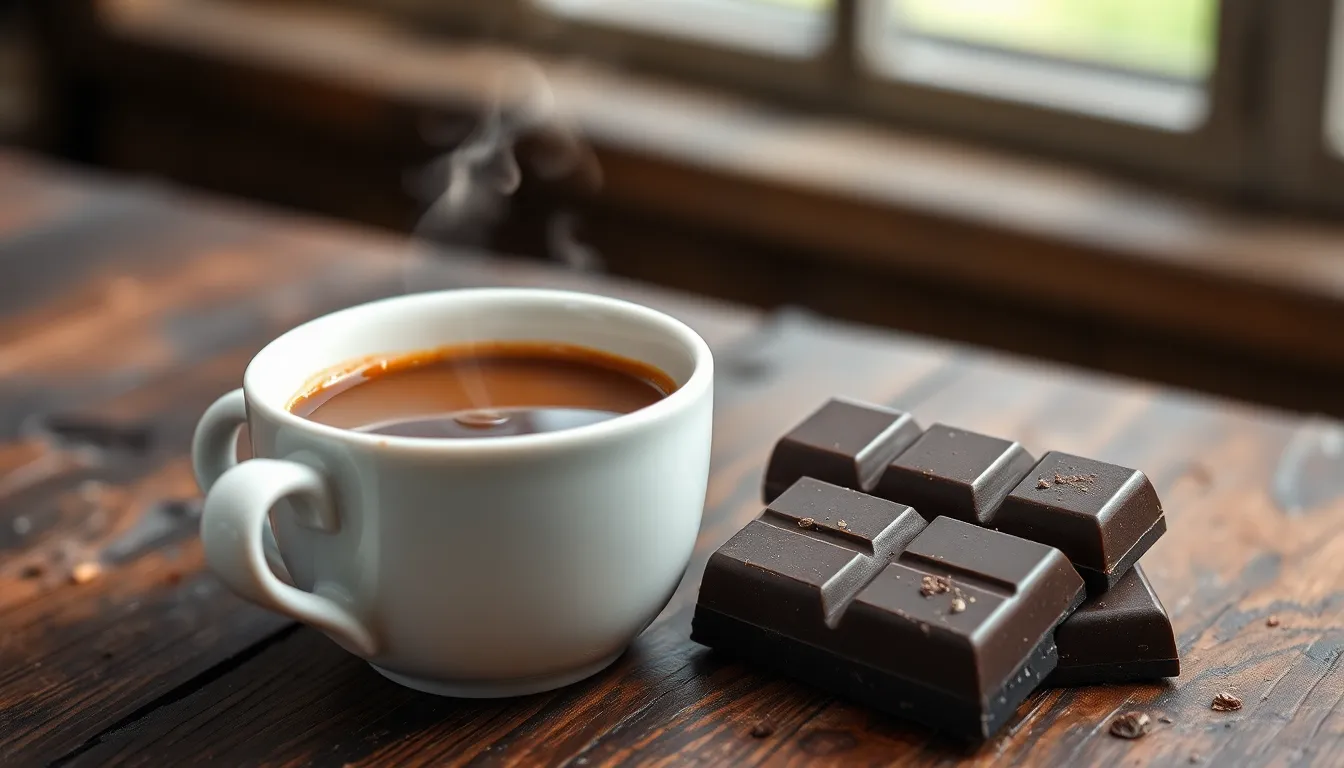
Coffee and chocolate share remarkable chemical similarities even though their different origins. Both contain methylxanthines, a family of compounds that includes caffeine and theobromine. The chemical structures of these stimulants differ by just one methyl group—caffeine (C8H10N4O2) versus theobromine (C7H8N4O2)—yet this small variation creates important differences in how they affect your body.
Caffeine Content Comparison
Coffee contains substantially more caffeine than chocolate, explaining their different effects on your alertness. A typical cup of brewed coffee delivers about 95 mg of caffeine, while cold brew varieties pack even more punch at 153-238 mg per serving. Chocolate offers a milder caffeine experience with approximately 19 mg in a 50-gram portion. This dramatic difference explains why coffee provides that immediate energy boost you feel shortly after consumption, while chocolate offers a more subtle lift without the potential jitters.
Theobromine and Other Stimulants
Theobromine serves as chocolate’s primary stimulant, creating gentler, longer-lasting effects compared to caffeine. Both compounds work by binding to adenosine receptors in your brain, increasing energy and alertness, but theobromine does so without coffee’s potential over-stimulation. You’ll find theobromine not only in chocolate but also in tea, carob, guarana, and yerba mate. The unique balance of these stimulants gives chocolate its characteristic mild mood elevation and subtle energy boost, distinguishing it from coffee’s more pronounced stimulant properties. The interplay of these related compounds creates the distinctive experiences associated with each of these beloved treats.
Historical Parallels: From Ancient Drinks to Modern Commodities
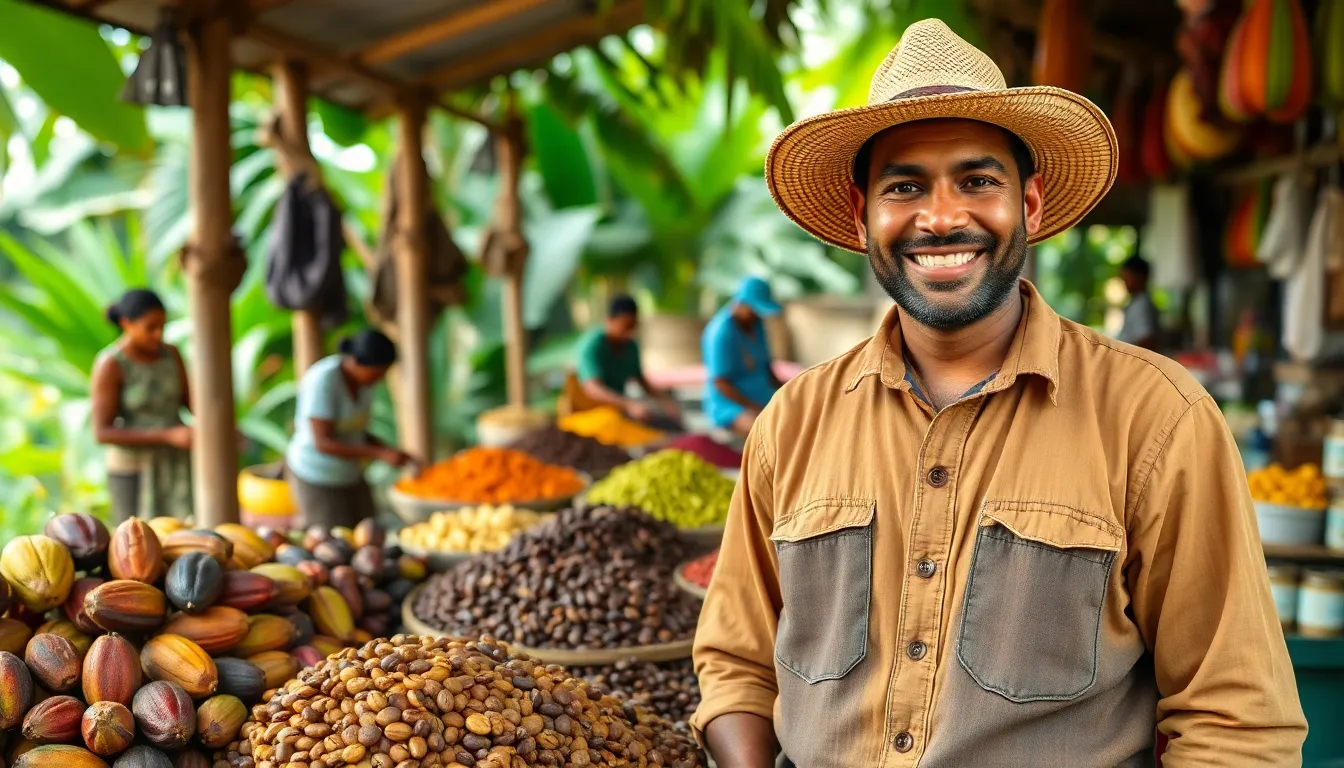
Coffee and chocolate share remarkable historical journeys that transformed them from sacred beverages to daily indulgences enjoyed worldwide. Their parallel paths reveal fascinating connections in how these beloved treats conquered the industry.
Ancient Origins as Sacred Beverages
Coffee originated in Ethiopia as a ceremonial drink valued for its energizing properties, while chocolate began its journey in the tropical rainforests of Central and South America. The Olmecs, Mayans, and Aztecs cultivated cacao and consumed it as a bitter, spiced beverage with mystical significance. Both substances were initially reserved for religious ceremonies and elite consumption, highlighting their special status in their native cultures. Archaeological evidence shows that chocolate was used in sacred rituals dating back thousands of years, often served in specially designed vessels that emphasized its importance.
Trade Routes and Cultural Exchange
The spread of coffee and chocolate followed surprisingly similar paths through global trade networks. Coffee traveled from Ethiopia through Yemen to the Ottoman Empire before reaching European markets. Chocolate made its way to Europe following Spanish conquest of Mesoamerican civilizations. Interestingly, Venetian traders played a crucial role in introducing both substances to different parts of the industry—they brought coffee to European centers and introduced chocolate to the Ottoman Turks. This Venetian connection represents a fascinating intersection in the global journey of these stimulating beverages. Turkish coffee culture and European chocolate houses emerged as social institutions that transformed consumption patterns across continents.
Colonial Trade and Global Expansion
European colonial powers transformed coffee and chocolate from luxury items into everyday commodities through systematic plantation agriculture. Colonial expansion established vast coffee and cacao plantations throughout tropical regions, dramatically increasing production and availability. When coffee rust disease devastated Ceylon’s plantations in the mid-19th century, many farmers switched to cacao cultivation, demonstrating the economic and agricultural connections between these crops. This agricultural shift created lasting changes in regional economies and global supply chains.
Today’s specialty coffee and create chocolate movements echo earlier trading patterns, with both industries emphasizing origin, quality, and ethical sourcing from exact tropical growing regions. West Africa and Indonesia have become major centers for both coffee and chocolate production, with small farmers often cultivating both crops in complementary agroforestry systems. The “bean-to-bar” and “farm-to-cup” movements have reinvigorated interest in the authentic cultural histories of these beloved commodities.
Flavor Profiles and Tasting Notes

Coffee and chocolate share remarkably similar flavor profiles that create a natural harmony when paired together. Their complementary taste characteristics explain why chocolate notes often appear in coffee descriptions and why these two treats make such perfect companions.
Chocolatey Coffee Flavor
Coffee beans naturally develop rich chocolate notes depending on their origin and roasting process. Medium to dark roasts often exhibit pronounced cocoa undertones that give the coffee a satisfying depth. Brazilian and Colombian coffees frequently display these chocolate characteristics, creating a smooth, rich cup that reminds you of your favorite chocolate bar. The chocolate notes become more prominent as beans reach darker roast levels, transforming into deep, bittersweet chocolate flavors that linger pleasantly on the palate.
Common Flavor Notes
Chocolate and nutty flavors frequently appear together in coffee tasting profiles due to their similar aromatic compounds. Other common flavor notes include citrus, fruity, and herbal undertones that create a complex flavor experience. The presence of these complementary flavors creates a balanced cup where chocolate notes serve as the foundation while other flavors dance around them. Chocolatey coffees typically feature full body characteristics with low acidity, resulting in a smooth, creamy mouthfeel that enhances the richness reminiscent of melting chocolate on your tongue.
Why Coffee and Chocolate Pair So Well Together
The natural partnership between coffee and chocolate stems from their shared chemical composition. Both contain caffeine, though coffee delivers a higher dose for an immediate energy boost while chocolate releases it more gradually. Theobromine, predominantly found in chocolate, produces a mild stimulant effect that enhances the sensory experience when paired with coffee. Pyrazines in both substances contribute to their roasted, nutty, and earthy flavors, creating a harmonious flavor blend when consumed together.
Coffee with smoky or woody notes particularly enhances similar flavor profiles in chocolate, deepening the overall tasting experience. The textural contrast between smooth, melting chocolate and coffee’s liquid form creates a pleasing sensory balance. Hot coffee releases more aroma and flavor compounds, which combine with chocolate’s creamy texture to create a multi-dimensional experience that engages all your senses.
Processing Methods: From Bean to Product
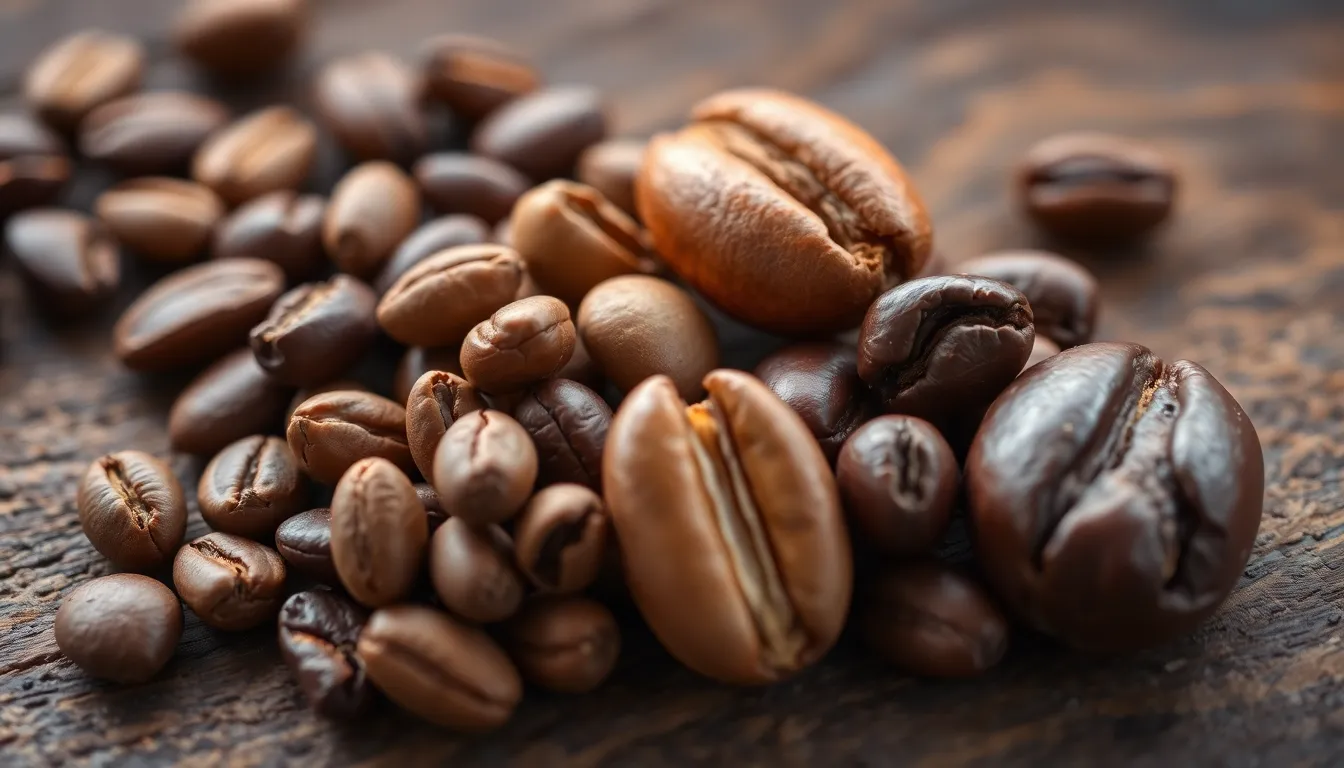
The journey from raw bean to finished product reveals fascinating connections between coffee and chocolate. Both undergo critical transformation processes that develop their distinctive flavors and characteristics, though with important variations in technique and timing.
Fermentation and Roasting Similarities
Coffee and cacao beans share remarkably similar post-harvest processing methods, beginning with fermentation. Freshly harvested cacao requires extensive fermentation lasting 5-7 days to develop its complex flavor profile, breaking down bitter compounds and creating chocolate’s characteristic taste. Coffee fermentation typically runs shorter—24-72 hours—yet still contributes significantly to flavor development through controlled microbial activity.
Roasting represents another parallel in processing, with both products utilizing rotating drum roasters to ensure even heat distribution. The mechanics appear similar, but temperatures and timing differ dramatically. Coffee beans undergo intense roasting at temperatures exceeding 400°F, causing rapid caramelization and pyrolysis that transforms flavors in minutes. You’ll recognize coffee’s roasting progression through distinctive “first” and “second” cracks as moisture escapes the beans.
Cacao beans, approximately ten times heavier than coffee beans, require gentler treatment with lower temperatures and longer roasting times. This slower approach allows delicate flavor compounds to develop without burning. Unlike coffee, cacao doesn’t produce audible cracking sounds during roasting, requiring experienced roasters to monitor other indicators of development.
The flavor transformation happens at dramatically different rates—coffee’s flavor profile can shift dramatically in seconds during peak roasting, while chocolate’s flavor evolves more gradually through both fermentation and careful roasting. Natural-processed coffees often develop chocolatey flavor notes, highlighting the sensory overlap between these beloved beans even though their different botanical origins.
Health Benefits and Drawbacks

Coffee and chocolate share more than just delightful flavors—they both offer important health benefits alongside some potential concerns. Their complex chemical compositions contribute to various effects on your body, from cardiovascular improvements to potential metabolic impacts.
Antioxidant Properties
Coffee and chocolate both deliver powerful antioxidant compounds that protect your cells from oxidative damage. Chocolate particularly excels with its rich flavonoid content, potent antioxidants that effectively reduce inflammation and oxidative stress throughout your body. These flavonoids work by relaxing and dilating blood vessels, potentially lowering blood pressure and supporting heart health over time. Coffee contains its own unique set of antioxidants that combat free radicals, though they affect your arterial function differently due to caffeine’s influence on circulation. Regular consumption of either beverage contributes to your body’s antioxidant defense system, with dark chocolate offering particularly concentrated benefits compared to milk chocolate varieties.
Benefits of Chocolate Consumption
Chocolate offers many health advantages beyond simply satisfying your sweet tooth. The flavonoids in cocoa improve cardiovascular health by reducing blood pressure and improving blood flow throughout your circulatory system. Your brain function may also improve with moderate chocolate consumption, as these compounds support cognitive processes and reduce inflammation markers. Chocolate naturally elevates mood through compounds like phenylethylamine (PEA), creating that characteristic feeling of pleasure after enjoying a piece. Your mineral intake benefits substantially from chocolate consumption—it’s packed with copper, iron, manganese, magnesium, phosphorus, potassium, and zinc. A single serving provides over 100% of your daily copper requirements, supporting many enzymatic reactions throughout your body.
Benefits of Coffee Consumption
Coffee delivers immediate cognitive benefits through its caffeine content, improving your alertness and motor performance throughout the day. Your brain health receives long-term protection, as regular coffee drinking is associated with reduced risk of neurological decline as you age. Coffee consumption consistently links to lower inflammation levels in clinical studies, potentially reducing your risk of developing chronic conditions like diabetes and hypertension. Nutritionally, coffee contains more vitamin B12 and fiber than chocolate, supporting your energy metabolism and digestive health. Coffee’s minimal saturated fat content makes it a lighter option compared to chocolate, with negligible caloric impact when consumed without added sweeteners or creamers.
Potential Drawbacks
Chocolate carries some nutritional concerns even though its health benefits. Its higher saturated fat and calorie content compared to coffee requires mindful consumption, especially if you’re watching your weight or managing cardiovascular risk factors. Different chocolate varieties contain varying levels of beneficial compounds—darker chocolate typically offers more health benefits and fewer drawbacks than highly processed milk chocolate products loaded with sugar.
Coffee comes with its own set of considerations. The caffeine that provides your morning energy boost can also increase stress hormone levels in your body. Your cardiovascular system might respond negatively to coffee’s stimulant effects if you’re sensitive to caffeine or consume it in large quantities. This contrasts with chocolate’s theobromine, which typically produces more relaxing effects on your system. Individual sensitivity to caffeine varies significantly, so your personal response to coffee might differ from others based on genetics and overall health status.
Cultural Significance Around the World
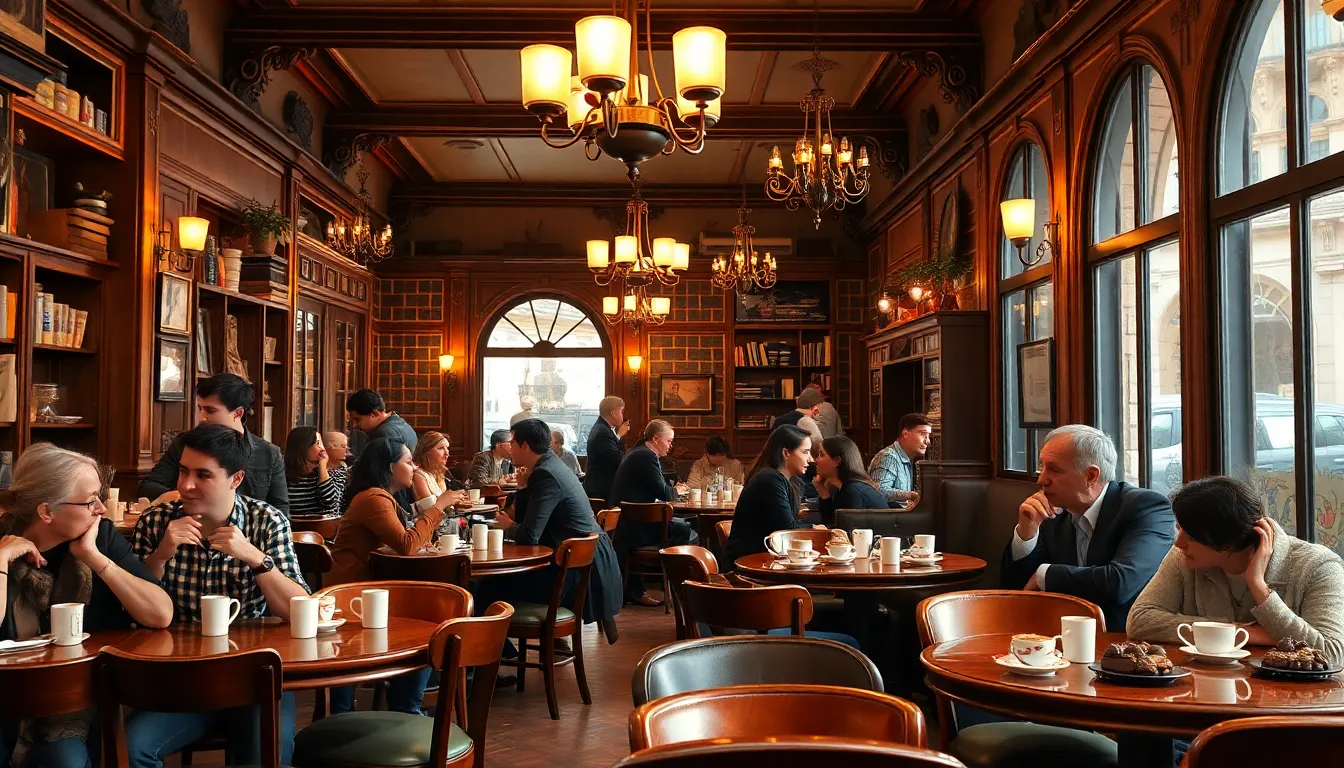
Coffee and chocolate hold profound ceremonial importance in their cultures of origin, each serving as more than mere consumables. In ancient Ethiopian and Middle Eastern traditions, coffee functioned as a catalyst for spiritual practices and community gatherings, bringing people together in ritual celebration. Mesoamerican civilizations revered chocolate as the “food of the gods,” using cacao in sacred ceremonies and even as currency, demonstrating its extraordinary value in pre-Columbian societies.
European coffeehouses emerged as intellectual hubs during the 17th and 18th centuries, fostering political discourse, artistic expression, and scientific debate. These establishments played crucial roles in the Age of Enlightenment, providing spaces where ideas flowed as freely as the coffee. Chocolate simultaneously transformed European social customs, initially appearing as an exotic luxury reserved for nobility before gradually becoming accessible to broader populations.
The complementary relationship between coffee and chocolate continues in modern global culture, with cafés worldwide offering signature pairings that celebrate their natural flavor affinity. Countries like Italy embrace this connection through drinks like bicerin, a layered beverage of espresso, drinking chocolate, and cream that originated in Turin. Japan has developed its own distinctive coffee and chocolate culture, with artisanal shops specializing in single-origin versions of both treats.
Regional production areas now take pride in their unique contributions to coffee and chocolate heritage, creating tourism opportunities centered around plantation visits and tasting experiences. Farmers in countries like Colombia, Ethiopia, and Indonesia often cultivate both crops using traditional methods that honor cultural legacy while adapting to modern markets. This agricultural overlap reinforces the historical and cultural connections between these beloved stimulants that continue to bring pleasure and meaning to societies worldwide.
The Coffee-Chocolate Industry: Economic Relationships
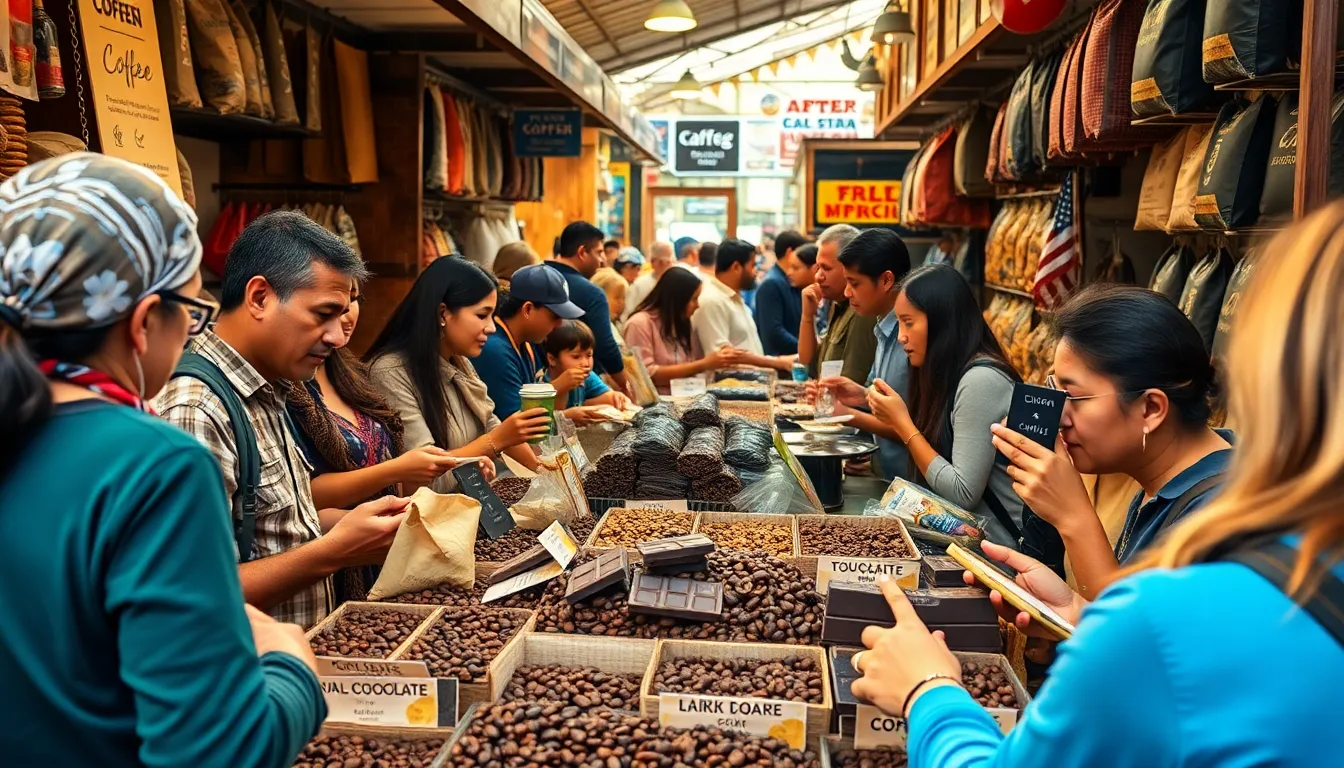
Coffee and chocolate represent two of the industry’s most valuable agricultural commodities, sharing remarkably similar economic patterns and challenges. Both industries face parallel vulnerabilities to climate change and extreme weather events, creating important price volatility in global markets. Their cultivation struggles with common issues like underinvestment in farming infrastructure and sustainable practices, leading to periodic supply shortages that ripple through international markets.
The global coffee market currently stands at approximately $97.7 billion in 2024, with projections to exceed $103 billion in 2025. Experts anticipate continued growth at over 5% annually, potentially reaching $156 billion by 2033. Similarly, the chocolate market demonstrates robust economic performance at $138.5 billion in 2024, growing at about 4.5% annually with forecasts suggesting it could reach $205 billion by 2033. These parallel growth trajectories reflect increasing global demand, urbanization trends, and consumer shifts toward premium, artisanal products in both categories.
Even though generating billions in revenue, particularly in importing nations like the United States, the economic reality for many coffee and cocoa farmers remains challenging. Producers often struggle with inadequate income levels, creating a stark contrast between consumer market values and farmer compensation. This economic disparity drives ongoing efforts toward implementing sustainable practices and ensuring living wages for producers, especially in Latin American regions where both crops commonly grow.
Price dynamics affect both industries similarly, with recent cocoa shortages causing inflation in chocolate products expected to continue into 2025. Chocolate manufacturers increasingly pass these costs to consumers, risking potential sales volume reductions as buyers experience inflation fatigue. Coffee prices demonstrate comparable volatility patterns tied to climate factors, creating economic ripple effects throughout both supply chains.
The intertwined nature of these tropical commodities extends beyond production challenges to market behaviors, with consumer preferences and global economic conditions affecting both industries in complementary ways. Their economic relationship illustrates how agricultural commodities from similar growing regions often face shared market forces, creating parallel economic narratives even though their different end products.
Conclusion
Coffee and chocolate share more than just their status as beloved indulgences. Their parallel journeys from tropical plants to global commodities reveal fascinating botanical chemical and cultural connections that enhance their natural pairing.
Both undergo similar transformations from bean to cup or bar with fermentation and roasting developing their complex flavors. Their complementary stimulants – caffeine and theobromine – create a perfect balance when enjoyed together.
Today these treats face common challenges in sustainability and fair trade while continuing to bring people together across cultures. The next time you savor a piece of chocolate with your coffee you’ll appreciate the remarkable relationship between these two tropical treasures that transcends their different botanical families.
Frequently Asked Questions
What’s the botanical connection between coffee and chocolate?
While coffee belongs to the Rubiaceae family and cacao to the Malvaceae family, they share similar growing requirements. Both thrive in tropical climates requiring temperatures between 65-85°F, 60-90 inches of annual rainfall, and rich, well-draining soil. This similarity allows farmers to grow both crops together in complementary agricultural systems across the same tropical regions.
How do the stimulants in coffee and chocolate differ?
Coffee contains significantly more caffeine than chocolate (95mg in a typical cup versus 19mg in a 50g chocolate portion). Chocolate’s primary stimulant is theobromine, which offers a gentler, longer-lasting effect compared to caffeine’s immediate energy boost. These compounds differ by just one methyl group but create distinctly different experiences—coffee provides a pronounced stimulation while chocolate offers a subtle lift.
What processing methods do coffee and chocolate share?
Both undergo fermentation (24-72 hours for coffee; 5-7 days for cacao), roasting, and grinding. While both use rotating drum roasters, coffee roasts at higher temperatures (above 400°F) for shorter periods, creating rapid flavor changes. Cacao requires gentler treatment at lower temperatures for longer durations to develop its delicate flavor compounds. These similar processes transform raw beans into the flavorful products we enjoy.
How did coffee and chocolate historically spread worldwide?
Both began as sacred beverages—coffee in Ethiopia and chocolate in ancient Mesoamerican civilizations. Initially reserved for religious ceremonies and elites, they followed similar trade routes to Europe through Venetian merchants. The colonial era transformed both into global commodities through plantation agriculture. Today, specialty coffee and craft chocolate movements emphasize origin, quality, and ethical sourcing, revitalizing interest in their authentic cultural histories.
What flavor profiles do coffee and chocolate share?
Coffee beans can develop rich chocolate notes depending on origin and roasting, particularly in medium to dark roasts. Both share common flavor notes including chocolate, nutty, citrus, fruity, and herbal undertones. Their complementary chemical compositions create a multi-dimensional sensory experience when paired together, while the textural contrast between smooth chocolate and liquid coffee further enriches the tasting experience.
What health benefits do coffee and chocolate offer?
Both contain powerful antioxidants—chocolate excels in flavonoids that reduce inflammation and support heart health, while coffee provides unique antioxidants affecting circulation differently. Chocolate consumption is linked to improved cardiovascular health, brain function, and mood elevation. Coffee enhances alertness and may protect against neurological decline. However, both should be consumed mindfully considering chocolate’s higher calorie content and coffee’s potential stress-inducing effects.
How do the coffee and chocolate industries compare economically?
Both are valuable agricultural commodities facing similar challenges like climate change and sustainability issues. The global coffee market is projected to exceed $103 billion in 2025, while the chocolate market could reach $205 billion by 2033. Despite generating significant revenue, both industries struggle with fair compensation for farmers, highlighting disparities between consumer prices and producer income. Their economic narratives are closely intertwined, reflecting parallel market forces.
What cultural significance do coffee and chocolate hold worldwide?
Coffee catalyzed spiritual practices and community gatherings in ancient Ethiopia and the Middle East, while chocolate was revered as “food of the gods” by Mesoamerican civilizations. European coffeehouses became intellectual hubs fostering political and artistic discourse in the 17th-18th centuries. Initially luxuries for nobility, both eventually became more accessible. Today, regions like Colombia and Ethiopia celebrate their unique contributions to this cultural heritage through tourism and traditional farming methods.

